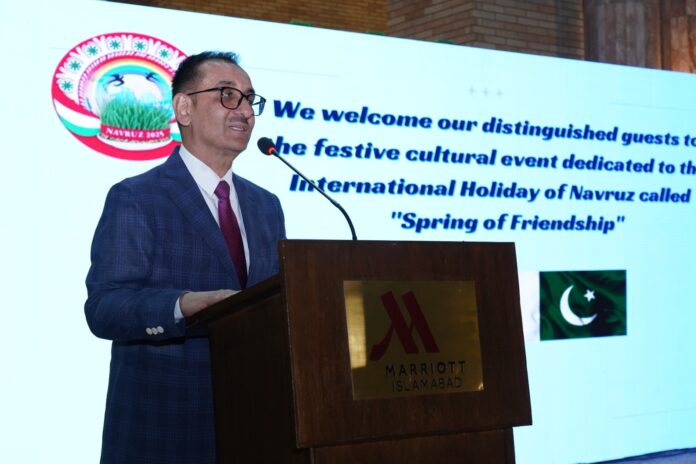- Advertisement -
ISLAMABAD, Apr 27 (APP): Ambassador of Tajikistan to Pakistan, Sharifzoda Yusuf Toir has said that ‘Navruz’ is a symbol of rebirth, unity, love and happiness in Tajikistan and other regional countries, which have been celebrating this festival for centuries in welcoming spring.
Navruz has been celebrated with enthusiasm for centuries in regional countries including Tajikistan, Iran, Uzbekistan, Turkmenistan, Kyrgyzstan, Kazakhstan, Kyrgyzstan, Pakistan and others Iraq, Mongolia, Bangladesh and China, which shows the mutual cultural unity between these countries, the Ambassador said.
Ambassador of Tajikistan to Pakistan, Sharifzoda Yusuf Toir said this in reception and Exhibition of Art and Culture organized by the embassy of Tajikistan here.

The Ambassador said that the colors of the ‘Navruz’ festival are new and different in all countries, including the region, and the Tajik nation also has a unique way of celebrating this historical festival.
Tajikistan is historically the torch bearer of a great culture, the colors of which are prominent in the culture of Tajikistan and other festivals, including ‘Navruz’, which are a source of interest for other nations.
Tajik envoy said that similarly, the civilization and culture of Tajikistan has embraced ‘Navruz’ for many centuries and spreads its colors every year on the occasion of the festival.
The ‘Navruz’ ceremony in the embassy of Tajikistan in Islamabad, today is certainly unique and significant. For four days, women and men in our embassy have been busy preparing various types of Tajik traditional dishes.
He said that today, the guests here will be served the special Nowruz dish “SUMANAK”, which is certainly the best example of the Cousine of the Tajik nation.
SUMANAK, SUMALAK, SUMANAKPAZI, is one of the Tajiks’ ancient traditions of cooking the herbal dish based on the wheat grown out in the eve of ‘Navruz’.
Sumanak absolutely differs from other dishes. And it represents a very good food value; wheat is a basic raw for sumanak.

During Navruz in Tajikistan, the main dish is sumalak, a sweet pudding made from sprouted wheat, prepared in a large cauldron and shared with the guest, he said.
Other Navruz dishes include oshy palov (Tajik pilaf), halva, dalda, sambusa, and various sweets also served to the guests today.
One of the most beloved dishes in Tajikistan is pilaf, which consists of rice, meat, onions. There are several types of pilaf in the country, for it is prepared differently in every region.
Meanwhile, highlighting the significance of this festival, he said that ‘Nowruz’, meaning “new day” in Persian, marks the spring equinox and the start of the new year in the Persian solar calendar.
He said ‘Navruz’ is celebrated with diverse customs and traditions, including the Haft Seen table (seven items starting with “s” symbolizing new beginnings).
‘Navruz’ has roots in our region, an ancient Persian civilization, and is one of the world’s oldest continuously celebrated festivals, he said.
He said the United Nations recognizes March 21st, 2009, as International Nowruz Day, acknowledging the holiday’s cultural significance and the diversity of its celebrations.
The envoy said this festival represents the start of the new year and renovation of nature. It’s celebrated in Middle Eastern and Central Asian countries but is of a main importance in Tajikistan.

